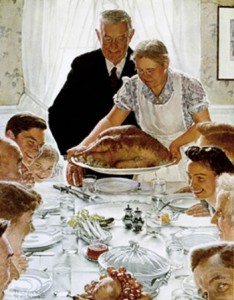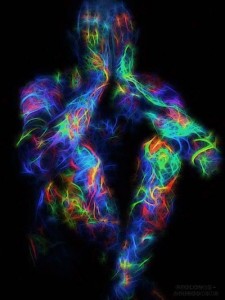
Tag Archives: The INNERnet
Thanks to Oprah, gratitude journals were all the rage a while back. And while most wouldn’t peg me as a hipster, thanks-giving has real appeal. That’s because the simple act of gratitude can upshift our immune system. And the on going practice of giving thanks can actually change us at the level of our DNA–maybe more.
Cell biologist, Dr. Bruce Lipton, has a great DVD presentation called, “The Biology of Perception.” In it, he outlines some fascinating fundamentals about how we function at the cellular level, and how that translates to the way we are in the world at large.
In his presentation, Dr. Lipton wonderfully explains the notion that our bodies are always operating in one of two basic modes: growth or protection. Always [and only] one mode or the other. Never both. This paradigm overlays perfectly with the work of Gary Zukav who says we constantly move between two inner states: love or fear. Dr. Lipton describes love to be the number one ingredient for supporting growth in humans. Gratitude is love: love for someone, love for something, love for someplace, love for some belief. All gratitude.
This is where it gets interesting. Our body’s general mode of living or being in the world begins at the level of perception. For example, I love racing motorcycles. Therefore, no matter how many others perceive racing as dangerous, when I race my systems kick into the growth mode since I perceive racing as awesome. When we are in growth mode, our immune systems are bolstered. That’s because when we are in a state of love or gratitude, healthy blood flow is maintained to the gut where the immune system is born. That’s unlike the mode of protection or fear, by which blood is forced out of the gut, to the arms and legs. For me, racing motorcycles establishes a state of love, born of gratitude, which produces growth or health in my body. That’s assuming, of course, I “keep the rubber side down.”
But that’s the thing. What do you think happens to the immune system of someone who cares about me, but perceives racing as dangerous, when she watches me on the track? That person’s body will go into protect mode. In protect mode, the body squeezes blood out of the gut and core organs, and sends that blood to the limbs, readying for fight or flight. Because this fear state robs the belly of blood, the immune system living in the gut of that person watching me race takes a hit. At that point, that spectator is far from a mode of gratitude. And this interrupts growth. All of this gets reflected in the hormonal and nervous systems. And all this has the potential, according to Dr. Lipton and others, to literally redo DNA. (Remember The INNERnet?)
We have the same external event, a motorcycle race, producing a growth response in one person and a protection response in the other. What creates the difference in responses? Not the race. It’s each person’s perception of the race. Think of the implications of perception, beyond a race. How often do we protect simply because of a perception? And what might happen if we had a growth response instead?
Here’s the last and maybe most interesting of Dr. Lipton’s points. This basic love/growth versus fear/protection process begins at the cellular level. He tells us that if you lay a single human cell in a petri dish, and put some form of nutrient near that cell, the cell moves toward the nutrient and grows. But if you put that same human cell in a petri dish and place a toxin near it, the cell moves away to protect itself.
Now multiply that basic process by trillions, the number of cells in each human being. Then multiply that by billions, the number of us on the planet. Dang, that’s a lot of cells and humans either growing or protecting. Nonstop, all of us are either growing or protecting!
So, gratitude and love expand us. Fear and protection contract us. What would happen if all the cells of all the people in the world expanded in gratitude at the same instant? It all starts with perception. Do we look out at the world and see good, or something else?
With that, the prescription for the health of our species comes into focus. When we all find reason for gratitude, the human race grows in love.
Happy thanks-giving.
Epigenetics is a relatively new study linking our psychological environment to molecular activity that may actually change the DNA we were born with. The INNERnet is that crisscross of chemistry and electronics in our bodies that is highly responsive to our thoughts, feelings and beliefs.
Early research in epigenetics uncovered that loving behavior by mouse moms actually altered not only the behavior of their babies, but their babies’ DNA!
Epigenetics later showed the psychological makeup of parents and grandparents can change the psychological makeup of offspring. What’s groundbreaking about epigenetics is that it also showed the psychological makeup of parents and grandparents can change offspring DNA. The genetic change happens at the molecular level when the methyl groups attach themselves to DNA. This attachment acts like a switch to turn certain DNA on. And when a particular DNA is switched on that person may be more prone, for example, to alcoholism or depression.
Consider a child with no genetic predisposition for depression born into a happy home. So far, so good. However, if one of that child’s parents becomes an angry person, that child may become sad. OK. Makes sense. But here’s the remarkable thing about psychological environments uncovered by epigenetics. If that parent’s anger persists, that child’s DNA may change in a way that supports depression.
That’s not all. More recent studies in epigenetics suggest that we, as individuals, can change our own DNA by our thoughts, feelings and beliefs!
This is where the idea of the INNERnet comes into play. I would define the INNERnet as the intricate web of neuropaths, cells and hormones in each of us that regulates how we feel, which can be biologically altered by our beliefs, thoughts and emotions.
Just like the Internet, the INNERnet contains an incalculable amount of data. And like the Internet, the data contained in our INNERnet can make us feel better or worse.
As we become more and more aware of ourselves, we recognize that the quality of our day to day lives is a product of what neuropaths we choose to fire. A wise woman, Paula Geiss, BSN, MSN, BBHS, once told me, “It’s all about how we run our energy.” If this sounds like electrical engineering, it is. We are an electrical system. If I flop on the floor because my heart has stopped beating, medics use electrical charges to bring me back. It’s this same electrical system that gets employed when persistent thoughts and feelings strengthen or weaken certain neuropaths.
Love this quote from Lin Yutang: “Hope is like a path on the hillside. Once there was no path, but as villagers traveled that place, a way appeared.” Those beautiful words were written well before our current understanding of neuropaths and neuroreceptors. And yet they perfectly describe what happens in the brain and on the surface of the cells, as we open ourselves more and more to hope, or any emotion. Here’s how it works.
The more we feel any emotion, the more the brain responds by strengthening the “path” (called a neuropath) supporting that particular feeling. Since there’s limited space in the brain, the more we feel one emotion and the more space is taken up in the brain by the neuropath supporting that emotion, the less space there is for neuropaths supporting other emotions. And usually our feelings result from our thoughts.
If we run our energy through the neuropath of, “I am enough,” certain hormones are released in our bodies that impact us at the cellular level. And epigenetics is telling us that if we run that kind of energy long enough, we might actually change ourselves at the level of DNA.
Of course, if we run our energy through the neuropath of, “I am not enough,” the same electrical and biochemical process ensues.
Once changed at the DNA level, the system now is predisposed to run that kind of energy. Either way, how we feel, moment to moment, will be impacted by the kind of energy we are running. And how do you want to feel? Better, right?
From Gandhi to gangster, aren’t all of us motivated to feel better? Did Gandhi’s altruism bring him a sense of inner well-being? Does the gangster do what he does to feel valued? And what if this isn’t selfish, but the way of life? And what if, in feeling better, we heal something in ourselves. And what if, in healing something in ourselves, we fear less and love more? And what if, in loving more, more of us heal?
By paying attention to our INNERnet, we can not only feel better. We can potentially change our bodies at the level of DNA in a way that increases our chances of sustaining that better feeling.
As a simple guide to “running good energy” and potentially shifting our DNA to a more supportive place, it’s not a bad idea to regularly check in with ourselves, and ask, “Is what I’m thinking right now making me feel better or worse?”; “Is what I’m feeling right now life-giving or life-taking?”
With practice, we can consciously choose thoughts and feelings that expand ourselves and others, rather than contract. If we stay the course, perhaps we can alter the DNA of our species.
Endorsed by two New York Times bestselling authors.”


